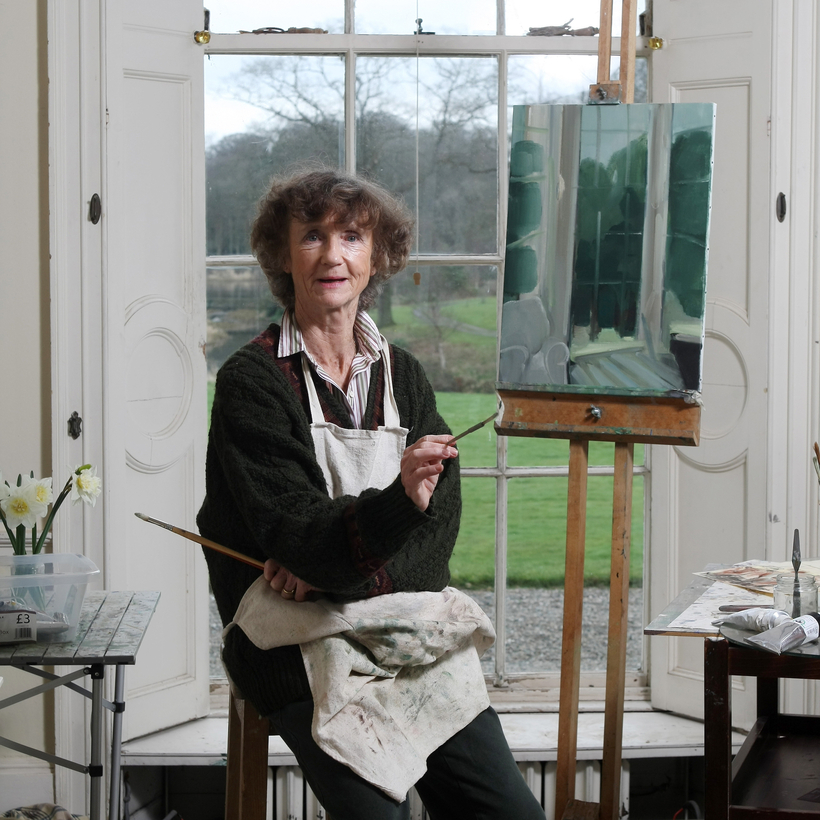I once bumped into my dear, late godmother, the painter Lindy Dufferin, at a party at Spencer House, the London home of Princess Diana’s family. Lindy gazed, rapt, at a line of businessmen queuing up to meet Prince Charles, as he then was. “Look—one of them’s actually sweating!” she said. “Why are they so scared?”
Lindy—or the Marchioness of Dufferin and Ava—had complete social confidence. She was the granddaughter of the Duke of Rutland and the daughter of Loel Guinness, an M.P. and hero fighter pilot in World War II. From an early age her life had been laid out along golden tramlines: flung from yacht to yacht with the Swans of Fifth Avenue; shuttling from the smart set in London to golf lessons with Ben Hogan in Palm Beach. She grew up with the likes of Truman Capote (“He was so wicked—I loved him,” Lindy said) and Gloria Guinness, her “It girl” stepmother. With her social X-ray specs she saw straight through rich men’s wealth to the frigid souls that lay beneath.

In 1974, Aristotle Onassis told Lindy that he wished he’d kept a diary, like her, “to be able to recall incidents which at a later date would be of use in a lawsuit.” Jackie O, by contrast, Lindy wrote, “is as thin and breathless, hypnotic and charming as she should be.”
Lindy reacted to the cold frivolity of her youth by developing an unusual capacity for warm empathy, and she harnessed her intense energy rather than settle for the lotus-eating existence expected of her.
Her husband, Sheridan, the Marquess of Dufferin and Ava, set up the Kasmin Gallery with John Kasmin, dealing in early David Hockney works. A Bigger Splash used to hang in the Dufferins’ sitting room in London, and Lindy, like her husband, became a gifted art collector.

Sheridan died of AIDS in 1988, aged only 49. Lindy was always completely open about his gay affairs and his diagnosis. She talked often about his bravery: how he’d never complained for a second as he lay dying.
A Bigger Splash used to hang in the Dufferins’ sitting room in London.
After his death, she turned her hand to his Clandeboye estate, in Northern Ireland. Her business ideas were many and varied. She poured her attention into the estate’s dairy herd and ended up producing the best cows in the country. The addition of an anaerobic digester—which turned agricultural by-products into electricity to power the house—followed, as did the spectacular success of Clandeboye’s award-winning yogurt.

She supported a forest school in the estate woods, where children could learn about nature, and entered into new ventures with the Royal Botanic Gardens at Kew, which sent experts over to research the estate’s woodland and gardens. She opened the whole of Clandeboye to filming and particularly liked the deal where she managed to get British Telecom to restore Helen’s Tower, a folly on the estate, in return for installing a telephone mast there.
She was intensely interested in Northern Irish politics. But, during the Troubles—the violent, sectarian conflict that lasted for 30 years—she never tied her colors to one side. In 2000, to celebrate her donation of a large tract of woodland for local people to enjoy, she had political councillors of all shades over for tea at Clandeboye.
All the while, she painted furiously. Tutored in her youth by Bloomsbury artist Duncan Grant, she exhibited for 60 years in Cubist and abstract styles. In her realist works, she drew on the English and Irish traditions of landscape painting.

She was one of the last great hostesses. Everyone from Van Morrison to King Charles III descended on Clandeboye. One weekend in the mid-1970s, Lindy invited the great American poet Robert Lowell, who was married to her sister-in-law, Caroline Blackwood. Also staying were several hearty types, there for a shooting party. Lindy arranged for Lowell to give a poetry reading on Saturday evening in the library. The hearties availed themselves of the drinks tray and took their places beside Lindy as the great man of American letters began his recital.
“And, one by one, these brutes in their shooting socks tiptoed out of the room to go and have a drink,” said Lindy. “By the time he finished, only Caroline and I were left in the room.”
Her allergy to self-indulgence guided her toward charity. When she sold a Lucian Freud painting (Freud had also been married to Caroline Blackwood), she used the proceeds to endow her charitable foundation to help the forest school in the Clandeboye woods.

After going to see a Freud exhibition, she wrote in her diary, “My little picture is there. It held its own—it was generating all those children in the woods: I find this thrilling. I could have bought a house in Portugal and could be there now but I would not be as happy and fulfilled as I feel this morning.”
Everything she did she did for others. How I adored her—and miss her.
Harry Mount is a London-based journalist and the editor of The Oldie. He edited The Last Marchioness: A Portrait of Lindy Dufferin, which is available exclusively at Heywood Hill


